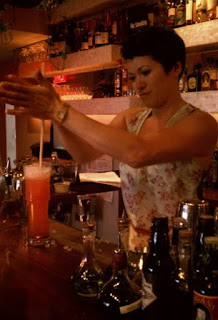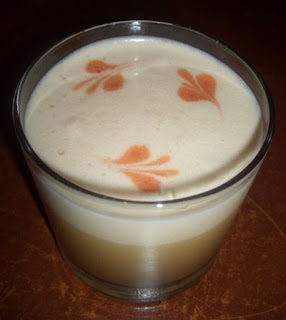1. Visiting New Bars in Boston
Boston gained a lot of new bars this year, and we witnessed an exciting diaspora across town as well as receiving new talent from elsewhere. I did write a preemptive post about four bars opening at the end of this year and three of them did open. What I was surprised about was how different these three were. With Jackson Cannon's new bar, Hawthorne, there is a formal feeling to the precision and presentation of the experience. Patrick Sullivan and Misty Kalkofen's Brick & Mortar is at the opposite end of the spectrum with a slightly divier feel with rather inventive cocktails. Journeyman and Sam Treadway's Backbar has a very intimate and comfortable feel to it. Other recently opened and soon to be opened bars like Hair of the Dog and Max Toste's Lone Star Taco Bar await.

While I mainly write about Boston, I did have the opportunity to travel this year. In June, we found ourselves in Chicago, and I took up bartender Paul McGee's offer to visit him at the Whistler. Of course, July was Tales of the Cocktail so I was able to have drinks at the Cure for the third year in a row. When I ordered my first drink this time, King Vittorio's Cobbler, I was quite impressed when the bartender immediately remembering that he made me a Cobbler the last time I was in there a year before! In September, I attended my brother's book launch party in New York. Before that event and after getting lunch, I was able to fit in visits to Vandaag and Lani Kai. I was a bit surprised when I walked into Lani Kai, and April Wachtel (who used to work at the Gallows here in Boston) was behind the stick! While not in a different state, Worcester was one of our destinations this year. We paid visits to Armsby Abbey and the Citizen; we have yet to visit Still and Stir, the bar that the Citizen moved its bar program to (within the same building complex) that is open Thursday through Saturday.
3. Science!
In March and April, I did a series of experiments studying the effects and importance of chilling one's glassware. I compared ice water vs. freezer chilling, how long each technique would take to cool the glass effectively, and what role could glass weight, shape, and thickness play in the process. I also attended a great seminar held by Harold McGee and Dave Arnold on the Science of Cocktails with great tips on carbonation and capturing flavors.

One of the trends we have been excited about is beer cocktails, and I was privileged to host another Mixology Monday this year and use beer cocktails as the theme. Looking back at all the beer cocktails I have had while out in Boston in 2011, I have to give props to Trina's Starlite Lounge, Hungry Mother, No. 9 Park, Stoddard's, Estragon, Lineage, Russell House Tavern, and Ben Sandrof's Sunday Salon for broadening my experience this year!
5. Press!
While I do a lot of writing about other people, it was quite flattering to have some of that in return this year. Susanna Bolle of WBUR Public Radio Kitchen has written about the blog twice this year: once in March about the blog in general and the glass cooling experiments, and once in October about a Becherovka drink Sean Frederick made me at the Citizen. The blog even got a mention on CNN's Eatocracy blog about the glass chilling work. I forgot which month the book came out, but some of my pointers about eggs were quoted and put into Gary Regan's Annual Manual for Bartenders 2011. I was also interviewed after Tales of the Cocktail in The Feast about new trends, but that site seems to have gone the way of the dodo (Google cache still has the article though). Moreover, drinks I had created were written about in CitySip, A Jigger of Blog, Mutineer Magazine, and elsewhere.

One of the most useful smartphone apps to come out this year was On the Bar which allows bartenders to check in and imbibers to figure out who is working around town -- the 4Square for bartenders that everyone wished would happen, did in fact happen. After prototyping the software and giving advice, the main developer asked if I would be willing to do write ups on the bars. While I wrote up the first 16, a few more have appeared in my style which I find rather flattering, but overall I am glad that I played a small role in this app's development.
7. Writing Other than Here
I mentioned that I had written copy for the On the Bar app, but 2011 also saw my writing in other venues. This year I was asked to write a LUPEC column about Tales of the Cocktail in the WeeklyDig; the honor also garnered me the DUDEPEC name of Screwdriver for my efforts. In addition, I participated in a post exchange with Sarah Lohman of the historic food and drink blog, Four Pounds Flour. While I wrote about Temperance drinks during the 1920s, Sarah contributed a piece about Averell Damson Gin. I also became the primary writer for the Mixoloseum blog where I cover of the weekly Thursday Drink Night recipes and provide summaries of the cocktail blog activity each week.

Speaking of Sarah Lohman of the Four Pounds Flour blog, I attended the Nineteen Century Pub Crawl that she hosted here in Boston. Not only did the participants get dressed up in period wear and speak in period talk, but the bars -- Eastern Standard, Stoddard's, and Drink -- stepped up and made the libation match as well. Some of the period tipples that I ordered were a Brandy Crusta and an Appetizer a l'Italienne, and punch and Blue Blazers also made their appearance. The side adventure to Lucky's while waiting to get into Drink was also an intriguing experience.
9. Books!
I did get a bit of reading done this year although not as much as I would have liked. These included David Wondrich's Punch, Jason Wilson's Boozehound, Lowell Edmunds' Martini, Straight Up, Christine Sismondo's America Walks into a Bar, Bernard DeVoto's The Hour, Richard Harwell's The Mint Julep, David Embury's The Fine Art of Mixing Drinks, and Victoria Moore's How to Drink (two-thirds done). Our bar's library also increased with new and old books alike with purchases of PDT Cocktail Book, Beta Cocktails, Big Bartenders Book, Esquire Drinks, Crosby Gaige's Cocktail Guide and Ladies' Companion and The Standard Cocktail Guide, David Wondrich's Killer Cocktails and others.

Yeah, I hit the same road block in my list last year, so I stole the text. This post will make #508 of the year which beat out last year's 400. No, I will not try to outdo this effort, but I will write as much as things move me to do so. More significant than the post number was the increase in traffic -- for the third year in a row, the blog has seen 75% growth each year (this does not include increases in RSS feed subscriptions which have also skyrocketed). I thought about writing #10 about room temperature cocktails as the hot, er... luke warm trend. Or about new spirits we have purchased and about ones we have reviewed like Ron de Jeremy. Last year, I ended with a story about having a seat at the Monteleone's Carousel Bar with Paul Clarke and closing the bar instead of getting much needed sleep for our 8am flight the next morning. This year, the New Orleans experience also proffered more insight into the end of one's time -- an Herbsaint-sponsored cemetery tour. Drinking Corpse Reviver #2 and Death in the Afternoon at the graves of Ramos and Legendre was a great experience. Pouring out some Herbsaint for our fallen bar heroes was a good way to look backward as we move forward in life. Cheers, and may 2012 bring you only the best in life and drink!



















 2/3 Brandy (1 1/2 oz Courvoisier VS)
2/3 Brandy (1 1/2 oz Courvoisier VS)
























 The 2017 collection of 855 drink recipes, bartender tributes, and essays on hospitality from CocktailVirgin's Frederic Yarm. Available at
The 2017 collection of 855 drink recipes, bartender tributes, and essays on hospitality from CocktailVirgin's Frederic Yarm. Available at  The 2012 collection of 505 drink recipes, techniques, and Boston bar recommendations from Frederic Yarm. Available at
The 2012 collection of 505 drink recipes, techniques, and Boston bar recommendations from Frederic Yarm. Available at 




